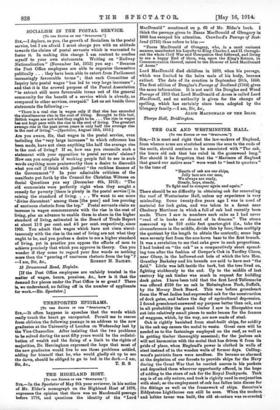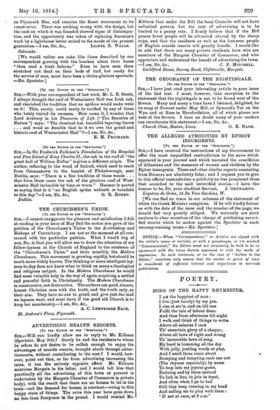THE OAK AND WESTMINSTER HALL.
[To THE Lone. or Tax n'Srecraros.."1 SIB,—It is meet and right that the law-makers of England, from whence arms are stretched across the seas to the ends of the earth, should continue to be associated with "The oak, the brave old oak that has ruled in the greenwood long." Nor should it be forgotten that the " Mariners of England that guard our native seas" were wont to " beat to quarters " to the tune of "Hearts of oak are our ships,
Jolly tars are our men, We always are ready, Steady, boys, steady, To fight and to conquer again and again."
There should be no difficulty in obtaining oak for renovating the roof of Westminster Hall, unless my experience is very misleading. Some twenty-fire years ago I was in need of material for lock gates, and was taken to a forest near Cleobnry Mortimer in which a fall of oak bad recently been made. There I saw in numbers such oaks as I had never "read of in books or dreamt of in dreams." The stems measured up to 210 cubic feet quarter-girt (i.e., take the circumference in the middle, divide this by four, then multiply the quotient by the length to obtain the content); some logs were seventy feet from the axe-hewn base to the first branch. It was a revelation to me that oaks grew in such proportions. I had looked on "the oak " as a comparatively short spread- ing tree after the fashion of Cowper's Oak in Yardley Chase, near Olney, in the hollowed-out bole of which the late Hon. Grantley Berkeley and his hounds are said to have met "the field." Little was left inside the bark, but the tree lived on, fighting stubbornly to the end. Up to the middle of last century big oak timber was much in request for building dock gates. I have been told that the first Lord Tollemache was offered £150 for an oak in Helmingham Park, Suffolk, by the Mersey Dock Board. This was before greenheart from the West Indies had superseded oak for the construction of dock gates, and before the day of agricultural depression. I found greenheart answered any purpose better than oak, and in all probability the grand timber I saw in Shropshire was cut into relatively small pieces to make beams for the frames of waggons, which, by the way, are now made of steel.
Oak is rightly banished from steel-built ships, for acidity in the oak sap causes the metal to waste. Great care will be needed as to the fastenings employed on the roof, as well as in getting timber thoroughly seasoned; for the jealous oak will not harmonize with the metal that has driven it from its pride of place, when England's power is clothed in walls of steel instead of in the wooden walls of former days. Coiling. wood's patriotic fears were needless. He became no alarmed at the depletion of our forests to provide ships for the Navy during the Great War that he carried acorns in his pockets and deposited them wherever opportunity offered, in the hope of adding to the store of oak for the Royal Dockyards. Teak sap is of an oily nature, and teak is rightly used in conjunction with steel; so the employment of oak has fallen into disuse for the fittings as well as the framework of ships. Smeaton's Eddystone Lighthouse can still be seen. When the modern and loftier tower was built, the old structure was re-erected - on Plymouth Hoe, and remains the finest monument to its constructor. There was nothing wrong with the design, but the rock on which it was founded showed signs of disintegra- tion, and the opportunity was taken of replacing Smeaton's work by a lighthouse better suited to the needs of the present
[We would rather see oaks like those described by our correspondent growing with the bracken about their knees "than read a fresh Inferno." Even to have seen them stretched out dead • on their beds of turf, but ready for the service of man, must have been a thrice-glorious spectacle. —En. Spectator.]











































 Previous page
Previous page